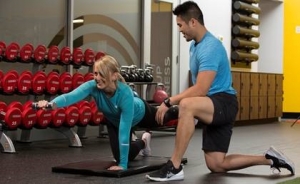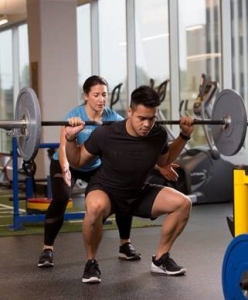| Influence of a Personal Trainer on Self-selected Loading During Resistance Exercise. J Strength Cond Res 31(7): 1925–1930, 2017.
https://www.youtube.com/watch?v=VGOAY4P6u5o&feature=youtu.be
As trainers, sometimes we under value our abilities and skill sets, but remember we can make a big difference to a client’s experience and success. Within SNFC, the application of the below research speaks to the importance of professional support within our facilities. Most new members walk into the gym with a goal, but most never receive fitness team assistance. The result, our members are less likely to 1. achieve their goals or 2. remain active members. If you doubt your ability to impact, make a difference or create value for every member, this study should help re frame your thoughts. Forget world class service, I am talking about 1. the most basic programming and supervision we can provide, a GA, and 2. four to six months of supervised training to ensure injury proofing & habit formation (i.e. Stages of Change). Below are research aligned reasons as to why our members need PT assistance:
- Integration into the gym & our equipment
- An assessment based, goal directed training program
- Education on progressive overload & appropriate intensities to create and optimize their outcomes
- Supervision & motivation to challenge them outside their comfort zone
- Accountability to the program & healthy lifestyle
Purpose of Study: The purpose of this study was to compare differences in muscle strength and self-selected resistance training intensities between trained subjects who: 1. trained under the supervision of a personal trainer (PT). 2. those who trained without supervision (WoPT).

Note: The PT group has trained with a trainer 2 days a week for at least 6 months. Procedures: Subjects performed 3 sets of 10 repetitions with self-selected weight for the leg press (LP), bench press (BP), leg extension (LE), and arm curl (AC). Results: Those in prior PT group chose higher & appropriate goal driven weights during their resistance training sessions. Self-selected training loads (i.e. % of 1RM) were significantly higher in Personal Training subjects compared with subjects without Personal Training for:
- Leg Press (by 15.6% ↑ than W/o PT),
- Bench Press (by 26.6% ↑ than W/ o PT),
- Leg Extension (by 12.1% ↑ than W/ o PT),
- Arm Curl (by 22.2% ↑ than W/ o PT)

| Self-selected training loads expressed relative to 1RM and 10RM data were significantly higher in PT: 1. 1RM: 49–59.5% WoPT Vs 62.7–77.3% PT 2. 10RM 41–58.7% WoPT ; 58.7–76.2% PT NB: the WoPT loads will limit calorie deficit, strength, hypertrophy gains NB: largest differences were observed in the lower-body exercises.
Meaning, those who use a Personal Trainer:
- Better understand their capabilities
- Lift at a higher % of 1RM,
- Are more likely to lift with an intensity required to achieve & optimize their goals,
- Are more likely to renew and want to set new goals
Conclusion: You have the ability to positively influence every member in our facilities.
Remember:
- Everyone needs your help to achieve their goals
- Members will under achieve when left to their own means
- Although this article doesn’t tackle injury rate, the ultimate goal is to safely and effectively deliver our members to their goals. Remember, on Average, 61% of members will be injured during the early lifespan of their membership. My expectation for nashFIT graduates and their clients is a 10% injury rate. Good trainers, help hold clients accountable to their behaviors, great trainer’s 1st bullet proof their clients, and then progressively push them beyond their limits. Think about the power we possess and confidently present it to every member you speak with.
|
|
|
|
|
|
|